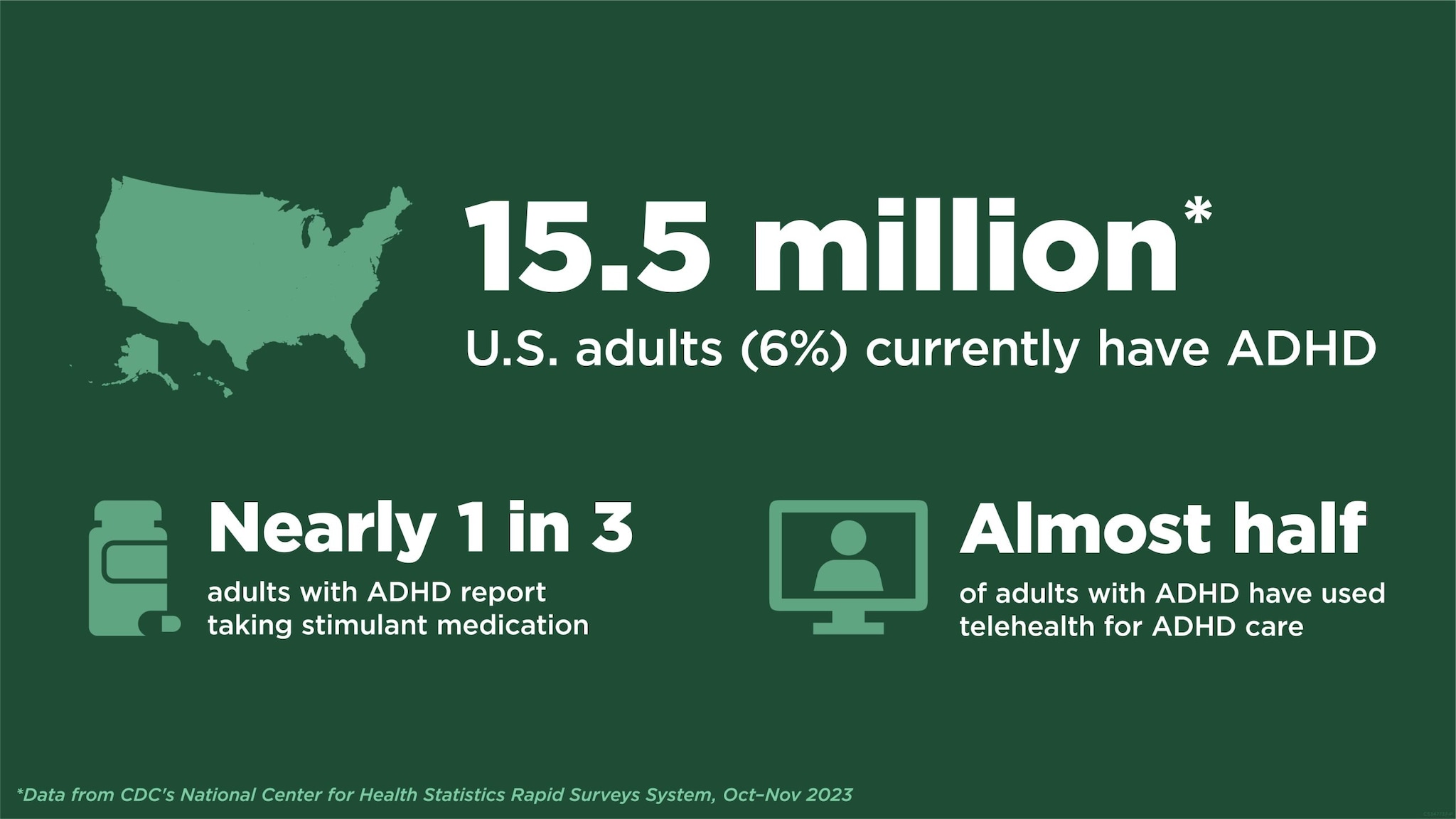Key points
- ADHD symptoms start in childhood and can continue into adulthood, but they may look different in adults.
- Just as ADHD symptoms and the way they impact daily living may change across the lifetime, needs for support and treatment may differ for adults and children.
- CDC collects data on ADHD in adults and works with partners to improve the lives of people with ADHD.

Overview
ADHD is a neurodevelopmental disorderA that develops during childhood and often lasts into adulthood. While ADHD is often thought of as a childhood disorder, some adults may have ADHD but have never been diagnosed.
This page provides information on what ADHD may look like in adulthood, how an ADHD diagnosis is made and what treatments are available, and additional resources to help individuals find services and support in their community.
Symptoms of ADHD in adults
ADHD symptoms can change over time and may look different at older ages. Hyperactivity, for example, may decrease or may appear as extreme restlessness. Symptoms may also become more severe when the demands of adulthood increase. The symptoms can cause difficulty at work, at home, or with relationships.
Adults with ADHD can struggle with:
- Managing their attention
- Completing lengthy tasks unless interesting
- Staying organized
- Controlling their behavior
- Hyperactive symptoms, such as feeling internally restless and fidgety

Especially in times when stress and demands are high, ADHD can cause difficulty with:
- Daily tasks
- Social relationships
- Consistency in healthy behaviors such as exercise, proper nutrition, and good sleep
- Avoiding health risks such as substance use, infections, and injuries
Did you know?
People with ADHD can request workplace accommodations from their employer. While not all people with ADHD will need accommodations to perform their jobs, others might find accommodations helpful in doing things like staying on task or limiting distractions while at work.
Diagnosis and treatment
ADHD symptoms can be severe and can cause difficulties with daily life. Without the right treatment and support, ADHD may seriously impact one's health and well-being.
Important
If you are concerned about whether you have ADHD, the first step is to talk with a healthcare provider to find out if the symptoms you are experiencing fit an ADHD diagnosis. A healthcare provider may diagnose ADHD themselves or refer you to a mental health provider.
Diagnosis
Diagnosing ADHD usually includes a checklist for rating ADHD symptoms and looking at the person's history of behavior and experiences. The provider will determine if ADHD symptoms were present before age 12 years and may ask for permission to gather information from friends and family. A medical and psychological exam may be needed to rule out other health problems that can cause symptoms like ADHD or that are often present with ADHD, such as anxiety, depression, sleep problems, alcohol or substance misuse, or learning disabilities.
Treatment
ADHD can often be managed with the right treatment. There are many treatment options, such as medication and therapy, and what works best can depend on the person and their environment.
Treatment for ADHD can include medication—most commonly stimulant medication—as well as therapy and other behavioral treatments, or a combination of methods. What works best depends on the person and their family. Effective treatment plans will include close monitoring, follow-ups, and making changes, if needed, along the way.
The American Professional Society for ADHD and Related Disorders (APSARD) is currently working to create U.S. Guidelines for Adults with ADHD.
Did you know?
The percentage of adolescent and adult females as well as male adults receiving prescriptions for stimulants used to treat ADHD symptoms increased during 2016–2021, particularly during the first two years of the COVID-19 pandemic (2020–2021).
Read the full CDC article on trends in stimulant prescription fills here.
Data on ADHD in adults

Data on ADHD in adults can help us better understand diagnosis and treatment patterns, and can help inform clinical care guidelines, approaches to addressing late diagnoses and medication shortages, and telehealth’s role in ADHD care.
Community resources
Education and support
- National Resource Center on ADHD | Overview for Adults
- National Institute of Mental Health | Attention-Deficit/Hyperactivity Disorder in Adults: What You Need to Know
Employment services
- Office of Disability Employment Policy (ODEP) - Job Accommodation Network (JAN): Attention-Deficit/Hyperactivity Disorder (ADHD) (askjan.org)
- Workplace Resources - CHADD
Building awareness
- Neurodevelopmental: having to do with the way the brain grows and develops. For more information on neurodevelopmental disorders, please visit: https://chadd.org/about-adhd
- National Institute of Mental Health (NIMH). Psychotherapies. Available at: https://www.nimh.nih.gov/health/topics/psychotherapies. Accessed on September 16, 2024.
- National Institute of Mental Health (NIMH). ADHD in Adults: 4 Things to Know. Available at: https://www.nimh.nih.gov/health/publications/adhd-what-you-need-to-know. Accessed on September 26, 2024.
